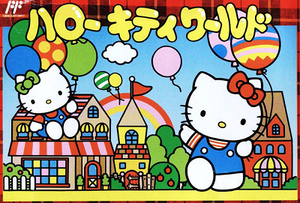Sanrio Wiki has moved from ShoutWiki. ^_^ If you want an account here (or to activate your old ShoutWiki account here) please email User:EvieMelody (chickasaurus@hotmail.co.uk) with a requested username, or ask her on Twitter. We'll send a new randomly generated password for you to change later via Special:Preferences.
Note: Sanrio Wiki is not official and is not run by Sanrio Co., Ltd. or related parties. This wiki uses some low resolution content (images, short sound clips) to describe articles, under fair use (for the purpose of illustrating and describing an article only). All rights are reserved by Sanrio and related parties.
Sometimes this wiki may be a little slow, other times it is faster. This is likely server related. On such days, you may want to stockpile edits offline for later.
Hello Kitty World (Famicom)
| Hello Kitty World | |

| |
| Developer(s) | Pax Softnica, Nintendo Research & Development 1 (Mario) |
| Publisher(s) | Character Soft |
| Director(s) | Seiji Hayashi, Hiroaki Satou, Chisumi Kuratani, Kuniko Sakurai, |
| Producer(s) | Hiroo Takami |
| Composer(s) | Hirokazu Tanaka ("sound programmer") |
| Release date(s) | |
| Genre | Flying platform game |
| Platform(s) | Famicom |
| Player mode(s) | 1-2 players (communication e.g. battling) |
| Serial code(s) | DMG-ATPJ-JPN (Kako-Hen), DMG-ATFJ-JPN (Mirai-Hen) |
| For the game released for Apple devices, please see Hello Kitty World (iOS). |
Hello Kitty World (Japanese: ハローキティワールド) is a video game published by Character Soft (a subsidiary of Sanrio) for Nintendo's Famicom game system (known outside of Japan as the Nintendo Entertainment System).
It was released on March 27, 1992 only in Japan.
In addition to the original developers (Nintendo Research & Development 1 and Pax Softnica; behind the base game Balloon Kid, Mario Co. Ltd worked on the production of this game, according to the back of the box art, while both ASCII Corporation and Sanrio worked on marketing.
According to a Computer Business Review news article from March 1991, Mario Co., Ltd was a joint venture between Nintendo and Dentsu (an advertising and public relations stock company) that was 51% owned by Nintendo and 49% owned by Dentsu, hence it is highly likely that this is the same company that worked on Hello Kitty World.[1]
Basis
Hello Kitty World is based on a Game Boy produced by Nintendo named Balloon Kid. Balloon Kid was previously released on October 5, 1990 in North America and January 31, 1991 in Europe, which featured characters Alice, her brother Jim and rival Samm. Hello Kitty World replaces these characters with Hello Kitty, her sister Mimmy and friend Tippy. Joey and Mory also appear as minor background characters.
The original version of Balloon Kid was never officially released in Japan. However, on July 31, 2000 an enhanced remake of Balloon Kid closer to the original game known as Balloon Fight GB was released exclusively to Japan via the Nintendo Power service for Game Boy. The Nintendo Power service allowed users to legally download software on to special re-writable cartridges "Game Boy Memory" or "SF Memory" cartridges, or purchase Nintendo Power cartridges with pre-written software.
Gameplay
The player has the choice of either playing alone or with another player. Hello Kitty must clear eight stages in a quest to rescue Tippy, and she has the ability to fly in the sky by inflating up to two balloons at a time. Hello Kitty can also collect 'stray' balloons and a HUD displays what stage Hello Kitty is currently on, the score, the number of stray balloons collected, and the number of lives she has.
Hello Kitty must avoid enemies that can defeat her or pop one of her balloons or she will risk losing a life. Bonus rooms can be found in stages where Hello Kitty can collect balloons coming out of pipes. After clearing each stage, a cutscene will play. After this a screen is shown where balloons are converted into points, and it is possible to obtain an extra life.
Certain stages have bosses. In order for Hello Kitty to defeat them, she must release all of her balloons and land on them from above multiple times.
Stages
Stages are marked with icons. What the icons depict are indicated under the "stage icon" column in the table below.
|